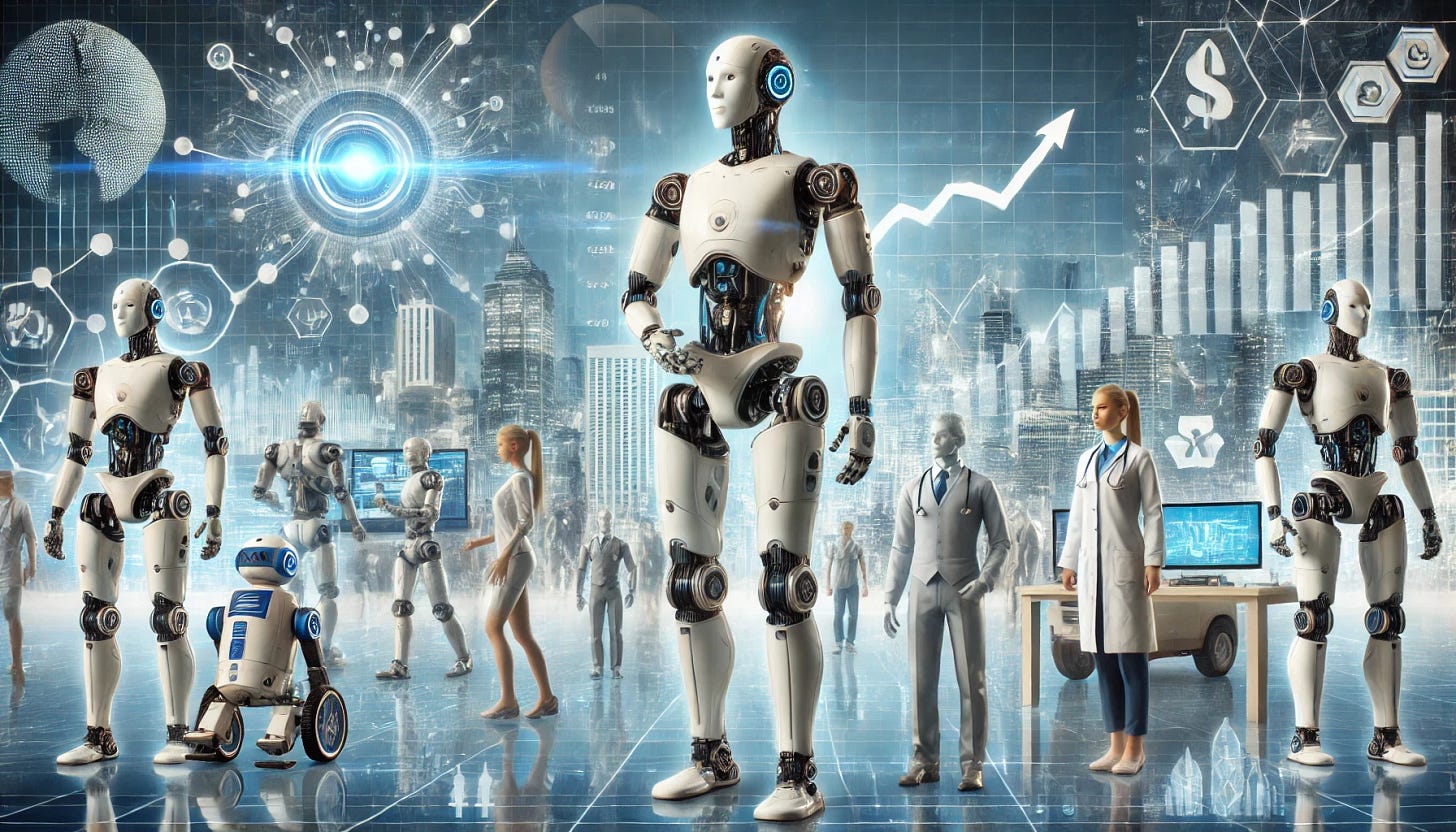Humanoid Robotics - The $3 Trillion Tech Revolution
Profiting from the Merger of AI and Robotics
Dear Tech Investors,
Today, we're diving deep into humanoid robotics, a trend that's set to revolutionize the tech landscape and potentially reshape 41% of the current US labor market.
🤖 The Rise of the Robots
The humanoid robotics market is projected to reach a staggering $3 trillion in the US alone. Early commercial deployments are expected as soon as 2028, with the potential to impact 62.7 million jobs across 21 different industries by 2050.
This isn't just about replacing workers - it's about augmenting human capabilities and addressing critical labor shortages in key sectors.
💼 Industry Disruptors to Watch
Tesla's Optimus robot is making waves, with CEO Elon Musk projecting that Tesla could produce over 100 million Optimus units annually, potentially eclipsing the 70 million cars produced globally each year.
Meanwhile, NVIDIA's Project GR00T aims to provide a foundation model for humanoid robots, with their AI computing power expected to reach 100 exaFLOPs by Q4 2024 - equivalent to about 300,000 of their high-end A100 GPUs.
Startups are also making significant strides. Figure AI, recently valued at $2.6 billion, has partnered with BMW to deploy humanoids in manufacturing plants. Agility Robotics' Digit robot is being tested by Amazon in its Seattle R&D facility, with plans for wider deployment.
🏭 Industries Primed for Disruption
Our analysis shows that certain industries are particularly ripe for humanoid adoption. Construction and extraction could see 70% of jobs potentially impacted, while 68% of production jobs, 64% of food preparation and serving roles, and 66% of healthcare support positions could be affected.
By 2040, we estimate 8.4 million humanoid units could be deployed in the US workforce, representing a $357 billion wage impact. By 2050, this could grow to 62.7 million units with a $3 trillion wage impact.
💡 Tech Trends Driving Growth
The number of AI research papers has grown by 34.5% annually from 2015 to 2023, indicating rapid progress in the field. Battery technology is also advancing quickly, with energy density improving by approximately 20% every two years.
The market for materials used in robotics is expected to grow at a CAGR of 18.3% through 2028, while the computer vision market is projected to reach $48.6 billion by 2027, growing at a CAGR of 7.3%.
📊 Investment Metrics to Watch
The global industrial robotics market is expected to grow from $43.8 billion in 2024 to $75.3 billion by 2027, a CAGR of 19.8%. The AI chip market is projected to see even more explosive growth, from $14.9 billion in 2023 to $128.9 billion by 2028, at a CAGR of 45.4%.
Our analysis shows potential cost savings of $500,000 to $1 million+ per human worker over a 20-year timeframe when replaced by a humanoid robot. Adoption rates are already accelerating, with robot density in manufacturing increasing from 66 robots per 10,000 employees in 2015 to 113 in 2023, a 71% increase.
⚠️ Challenges and Risks
While the potential is enormous, hurdles remain. Achieving human-like dexterity is still a complex challenge, with current humanoids having 16 to 60 degrees of freedom compared to over 200 in humans. With 41% of US jobs potentially impacted, societal resistance could slow adoption.
Regulatory uncertainty is another factor, as only 7% of countries currently have AI-specific legislation in place. Initial costs are also high, with current estimates putting advanced humanoids between $100,000 to $300,000 per unit, though this is expected to decrease significantly with scale.
💰 The Bottom Line for Investors
The humanoid robotics trend represents a paradigm shift in technology. While it's still early, the $3 trillion market potential and broad impact make this a critical space to watch. Our models suggest that by 2030, the US humanoids market could generate ~$4 billion in total revenue, growing to ~$240 billion by 2040 and potentially reaching ~$1 trillion by 2050.
As always, thorough research and diversification are key. We'll continue to monitor developments and provide insights to help you navigate this exciting new frontier in tech investing.
Happy investing!
Val
ABCD Tech Investing
P.S. What's your take on these projections? Which sector do you think will see the fastest humanoid adoption? Reply and let me know!


